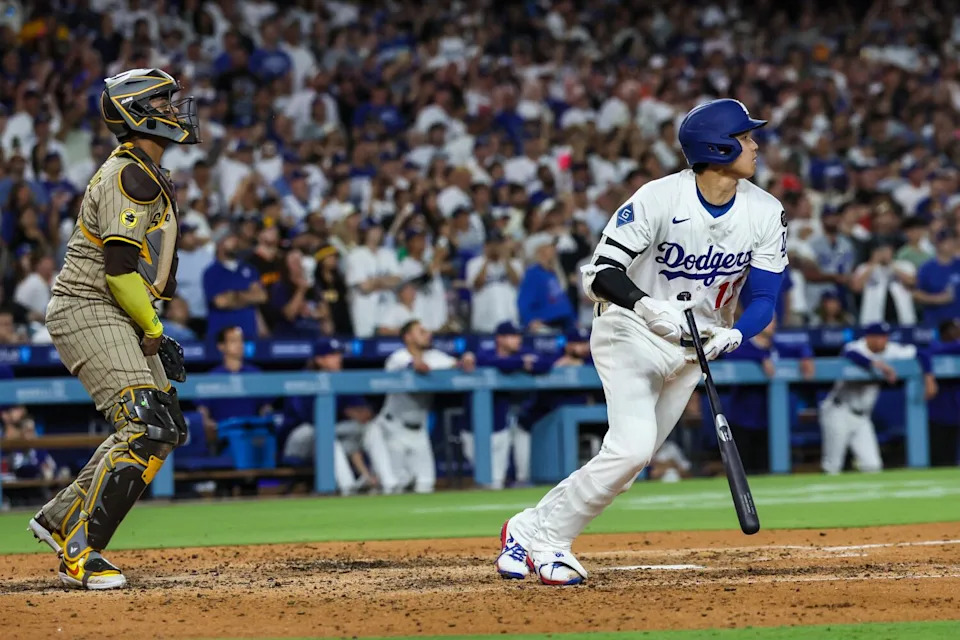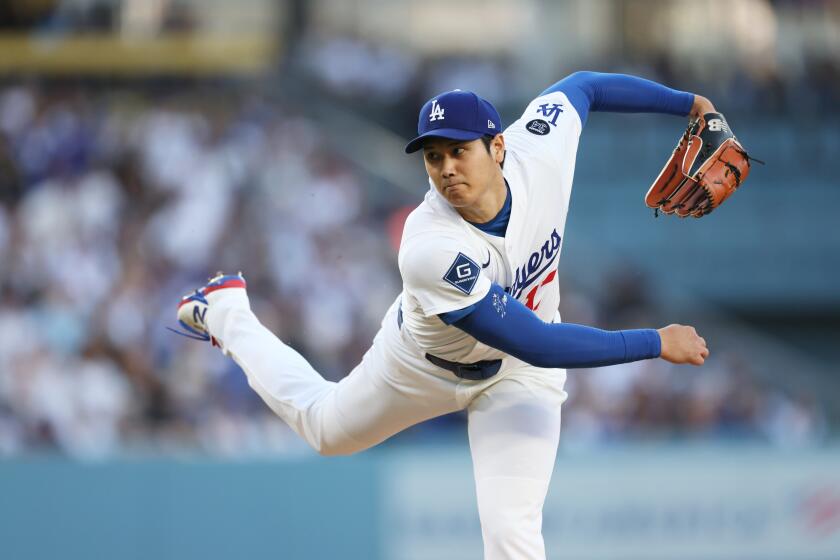Roughly four hours before first pitch Monday night, Shohei Ohtani sat at his locker in the Dodger Stadium clubhouse and prepared for a moment almost two years in the making.
First, the reigning MVP unwrapped the black compression sleeve he wears when pitching, and pulled it over his prized right arm. Then, he grabbed his bat and a pair of hitting gloves and headed toward the cages.
On this day, each piece of equipment was needed.
After a 663-day wait, the two-way star would be playing both ways again.
In the Dodgers’ 6-3 win against the San Diego Padres on Monday, Ohtani made his long-awaited return as a pitcher from a September 2023 Tommy John operation, taking the mound in a Dodgers uniform for the first time as the club’s starter while also continuing to serve as their leadoff hitter in the lineup.
For Ohtani, it was a return to normalcy — resuming the two-way role that made him one of the game’s preeminent stars from 2021-2023 while playing with the Angels.
But for the Dodgers, it was a mesmerizing new sight — the first time they’ve seen Ohtani pitch and hit for them since he signed his 10-year, $700-million contract two offseasons ago.
“We saw it from the other side, from afar, when he was with the Angels,” manager Dave Roberts said before the game. “So now, I think I got the best seat in the house to watch this guy start and then take an at-bat. This is bananas. So I’m thrilled.”
Ohtani’s pitching outing was brief, by design, lasting just one inning and 28 pitches. He yielded one run on two hits (a pair of flare singles from Fernando Tatis Jr. and Luis Arraez) and a sacrifice fly from Manny Machado. And while his fastball touched 100 mph — harder, he said, than he meant to throw it in his first outing back from surgery — his overall execution was far from flawless.
“I can’t say it’s a good performance results-wise,” Ohtani said in Japanese. “But just there being a feeling that I can throw again next time is a step forward.”
Ohtani’s command looked rusty, the right-hander missing the zone 12 times including one wild pitch. Though he got three swing-and-misses, he failed to finish any of his five two-strike counts with a strikeout (though Machado nearly went around on a two-strike sweeper, needing a generous check-swing call from an umpire before lifting his sac fly).
When Ohtani finally retired the side, it felt more like a sigh of relief, with his climbing pitch count already leading to action in the bullpen.
Yet, the ovation he received marked the momentousness of the occasion; reminding a sold-out crowd of 53,207 not only of his two-way capabilities, but also the tantalizing arsenal he still possesses even after a second career elbow reconstruction.
“To take this on — the physical [toll], talent-wise, the psychology of it — this is a big undertaking,” Roberts said. “As people say, he’s a unicorn.”
Read more: Hernández: Cowardly Dodgers remain silent as ICE raids terrorize their fans
Initially, it appeared the Dodgers would have to wait at least another month before seeing Ohtani pitch in a game. Despite some optimism before spring training that Ohtani could resume pitching in April or May, the team had been slow-playing his pitching program ever since the start of the regular season, long ago targeting some time after the All-Star break to add him into their rotation.
“This is such a unique scenario,” general manager Brandon Gomes said. “[We were] making sure we’re not doing anything to put the offensive side in jeopardy.”
In the last couple weeks, however, that calculus started to change.
First, Ohtani impressed coaches and executives in three different live batting practice sessions, working his way up to three innings and 44 pitches in his most recent one in San Diego last week.
Then, in meetings with team officials, Ohtani expressed some concern with continuing to build up in more simulated pregame sessions, relaying the toll it took on his body to pitch several innings in an afternoon before ramping up to DH later the same night.
Dodgers pitcher Shohei Ohtani delivers against the Padres on Monday. (Robert Gauthier / Los Angeles Times)
“The getting hot, throwing a live at 1:30, 2:00, cooling down, coming back, getting ready to lead off the game — I can’t even imagine how taxing that is,” said Gomes, a former big league reliever. “There is no playbook for this. So it had to be an ongoing conversation, and making sure that Shohei is the one driving this conversation.”
In recent days, Ohtani began to steer such conversations in a different direction; especially after the Dodgers indicated that, thanks to his status as a two-way player who wouldn’t take up a pitching roster spot, they were open to bringing him back as a pitcher even if he would initially only throw one or two innings.
“It [was] more of like, ‘Well, I don’t think there’s anything else to do. I’m ready to go. What else do I need to do to get back on a major-league mound?’” Roberts recalled of Ohtani’s message to the team. “You try to treat him like a normal pitcher and a normal ramp-up or buildup. But if [he only needs to be built up for] an inning or two, it’s, ‘Well, I’ve already done that.’”
Thus came the pivotal question.
“‘Can I pitch now?’” Roberts recalled Ohtani asking.
The answer, the Dodgers (44-29) decided over the last two days, was yes, slotting Ohtani in as an opener in front of bulkman Ben Casparius for Monday’s visit from the Padres (39-32).

Shohei Ohtani hits a run-scoring single in the fourth inning against the Padres on Monday. (Robert Gauthier / Los Angeles Times)
“We judged it would go smoother this way,” Ohtani said. “There were two routes: gradually stretching out in live batting practice to where I could pitch four or five innings, or to pitching short innings like today with the appropriate degree of strength.”
Ohtani’s return to pitching caused a stir around Chavez Ravine. Fans flocked down the left-field line when he emerged around 6:30 p.m. to begin warming up in the outfield. As he threw his pregame bullpen session, more spectators leaned over the railing to watch him, while teammates Yoshinobu Yamamoto and Tony Gonsolin gazed on from behind the mound.
In pregame introductions, Ohtani was announced twice: Both as the starting pitcher and designated hitter (MLB’s rules for two-way players, which were adopted a few years ago in the wake of Ohtani’s rise to stardom, allow for such a distinction in order to let Ohtani keep hitting once he finishes his pitching outing).
And after Ohtani completed the top of the first, he never even stepped foot in the dugout. Instead, a bat boy met him at the top step to hand him his hitting equipment. Veteran coach Bob Geren offered him a towel. Yamamoto also brought over some water, but Ohtani declined as he prepared to lead off the bottom of the inning.
“I always understood how hard it was to pitch and then come in and hit, but seeing him come off the mound and go to the dugout — I don’t know, it kinda hit a little different seeing it from our side,” third baseman Max Muncy said. “[He] didn’t even get a drink of water. Just put his helmet on, went right to the batter’s box. That’s really hard to do.”
As a hitter, Ohtani struck out in his first at-bat, but then tied the score with an RBI double in the third before contributing to a five-run rally against Padres starter Dylan Cease in the fourth with an RBI single.
Afterward, he expressed gratitude about being back on the mound, having waited almost 21 months since his Tommy John surgery to again feel the adrenaline — and, he acknowledged, nerves — that come with pitching in a game.
“I have only gratitude,” Ohtani said. “This was my second surgery, and the surgeon and trainers supported me. Regardless of the results today, I’m really grateful to people like that for helping me reach this point. I think it was good that I was able to let that out on the mound.”
Moving forward, Ohtani will likely continue to serve as an opener roughly once per week; building up to two innings, then three, and so on until he’s able to handle a normal starter’s workload.
The exact plan will depend on how he responds to his return to two-way duties, with the Dodgers remaining wary of pushing him too hard on the mound before the stretch run of the season.
Read more: Hernández: How Japan media track down Ohtani’s home-run balls
“As we said before, this is a unique situation, and making sure that he’s in a good place and we’re just taking it small bites along the way as far as what comes next is incredibly important,” Gomes said. “At each step, we’ll have those discussions and make sure that that is the guiding light, to make sure that he’s feeling as good as possible come October.”
Still, for one night, one inning of Ohtani pitching was more than enough to satisfy.
“I know he loves the challenge,” Roberts said. “And he just has a way of kind of focusing on whatever task is at hand. He enjoys that process of it. I don’t think he’s just kind of jovial about being a two-way player. I think he just really takes pride in being really good at it, too.”
Sign up for more Dodgers news with Dodgers Dugout. Delivered at the start of each series.
This story originally appeared in Los Angeles Times.
Read the full article here

